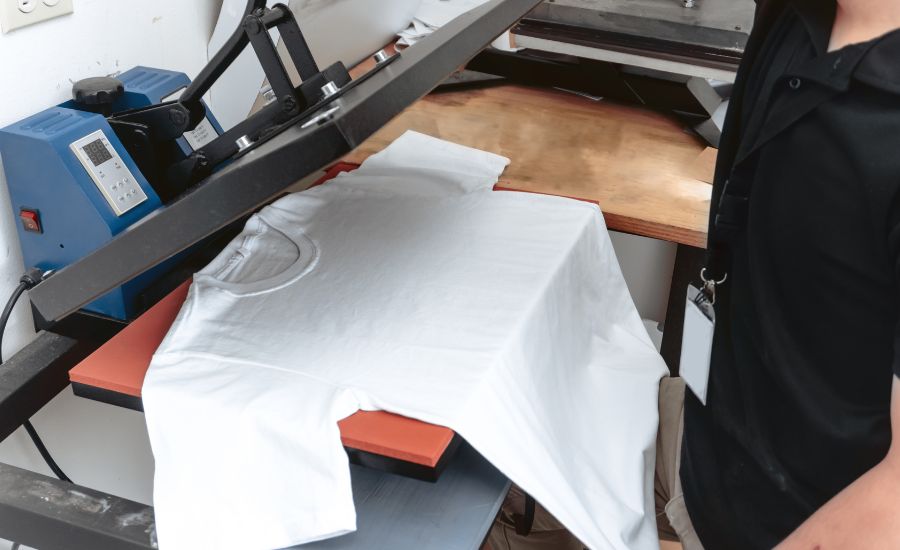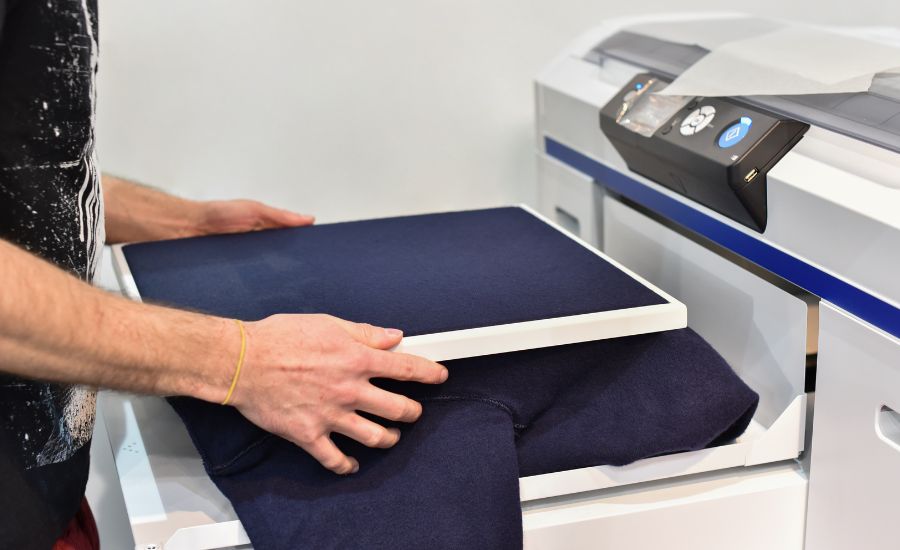Sublimation vs. DTG Printing? Sublimation printing and DTG printing techniques are two of the most popular methods for printing on textiles.
We will thoroughly compare sublimation printing and direct-to-garment printing, considering their advantages and disadvantages to help you decide which is best for your needs.

Print Quality and Color Vibrancy
Print quality and color vibrancy should be at the forefront of your considerations when evaluating printing techniques to achieve your printing goals on T-shirt.
Sublimation Printing: Vivid and All-Over Designs
Sublimation printing allows producing vibrant, full-cover designs on various surfaces, including T-shirt, and mousepad.
It utilizes heat to transfer ink from sublimation paper to a surface.
The design is printed onto the special transfer paper, which is then positioned atop the substrate and heated. The ink then sublimates, which penetrates the substrate and bonds to it, producing a permanent print on the blank tee.

DTG Printing: High-Resolution Prints
DTG printers offer exceptionally intricate and sharp prints with a high level of detail. It works by directly applying water-based inks onto the T-shirt using special inkjet printers.
This method excels at reproducing intricate designs with numerous colors and shades. Direct-to-garment is ideal for designs that require fine details and photorealistic images.
DTG vs. Sublimation Printing: Print Quality
The sublimation process is favored for producing designs with excellent color vibrancy.
Direct-to-garment printing is known for its detailed prints, making it suitable for photorealistic designs.
Fabric Compatibility
The type of material you intend to print on significantly affects deciding between sublimation and printing directly.
Sublimation Printing: Polyester and Blends
The sublimation printing method is most effective on polyester materials as the ink from sublimation printers forms a strong bond with the fibers of the fabric, making the prints last long and look bright.
While a sublimation printer can also be used on other materials like ceramic and metal, it’s primarily known for its effectiveness on polyester, such as t-shirts, hoodies, and mugs.

DTG Printing: Cotton and Natural Fibers
DTG printers are highly compatible with cotton and other natural fibers fabrics. The water-based ink used in garment printer adheres well to these materials, providing a soft feel and natural look to the prints.
Additionally, DTG printer equipped with white toner printing capabilities or regular inkjet printer can also handle dark-colored T-shirts effectively, providing vibrant prints on a wide range of materials.
DTG vs. Sublimation Printing: Fabric Compatibility
Dye sublimation is ideal for polyester, polyester blends, and hard substrates like ceramics and metals, using transfer paper during the printing process.
DTG printer is a great choice for cotton fabric, offering soft and natural prints.
Print Durability
The durability and longevity of your printed designs are important factors to consider, especially for commercial or promotional purposes.
Sublimation Printing: Long-Lasting
Sublimation prints endure for an extended period and exhibit resistance to fading. Since the ink chemically bonds with the fabric or substrate, it becomes a part of the material, making it highly resistant to washing and wear.
It is perfect for printing on T-shirt or other types of clothing.
DTG Printing: Soft and Comfortable
DTG prints also demonstrate resilience against fading, but they may not be as resilient to wear and washing as sublimation prints.
Nevertheless, they remain suitable for typical everyday purposes.
One advantage of DTG prints is their soft and breathable feel, which is especially appreciated in the clothing industry.
DTG vs. Sublimation Printing: Print Durability
The sublimation printing strategy offers blur-safe and durable prints on a T-Shirt that withstand repeated washing and exposure to the elements.
Direct-to-garment printing provides durable prints with a soft and comfortable feel.

Price and Volume
Budget considerations and the volume of printing you plan to do are crucial factors in your decision between sublimation and DTG.
Sublimation Printing: Economical for Bulk Production
Dye sublimation is often more cost-effective for bulk production due to printing designs on large quantities of items simultaneously. However, the initial setup cost for the process, including the heat press and sublimation printer, can be relatively high.
It may be more suitable for businesses with a consistent need for bulk printing as well as screen printing.
DTG Printing: Ideal for Customization
DTG printing technique is suitable for smaller runs and custom orders.
It allows for on-demand printing, making it cost-effective for businesses that offer personalized products or limited-edition designs.
It is advantageous for businesses with diverse printing needs, variable order sizes, and the flexibility to complement larger runs with screen printing when needed.
DTG vs. Sublimation Printing: Price and Volume
The sublimation method is cost-effective for bulk production but may have a higher initial setup cost.
Direct-to-garment printing is ideal for small runs and customization with diverse printing needs.

Conclusion
Consider factors such as fabric compatibility, print durability, and your budget to ensure that your chosen printing technology aligns with your printing goals and creative vision.
Sublimation printer excels in producing vibrant all-over designs with excellent color vibrancy, making it suitable for T-shirt of polyester fabrics and blends.
Direct-to-garment printing technique offers highly detailed and high-resolution prints, ideal for intricate and photorealistic designs, and is compatible with natural fiber fabrics like cotton.
FAQ
Is sublimation better than DTG?
Sublimation printing is considered to be the better printing method for high-quality prints on polyester-coated materials. It offers more vibrant and durable prints than DTG.
However, direct-to-garment printing is more affordable and a good option for printing on a variety of fabrics.
Which is better sublimation or digital printing?
If you need vibrant designs on polyester blend materials and fade resistance, then choose sublimation printing.
If you require highly detailed and photorealistic prints on cotton or natural fiber fabrics, then digital printing can fit perfectly.
Does sublimation last longer than DTF?
Sublimation printing generally lasts longer than DTF printing. This is because the ink in sublimation printing penetrates the fabric fibers and bonds to them at a molecular level.
Is DTG better than heat transfer?
DTG printing is the better method for soft and natural-feeling prints on various fabrics or T-shirts. However, heat press printing is a good option for a more durable print.
Is DTG ink the same as sublimation ink?
No, DTG ink is a water-based ink that is applied directly to the garment using a special printer. Sublimation ink is a dye-based ink transferred to the garment using a heat press.
What is the difference between DTG and sublimation printing?
If you are looking for natural-feeling prints on various fabrics, then DTG printing is a good option. If you are looking for vibrant and durable prints on polyester, then sublimation printing is a better choice.




